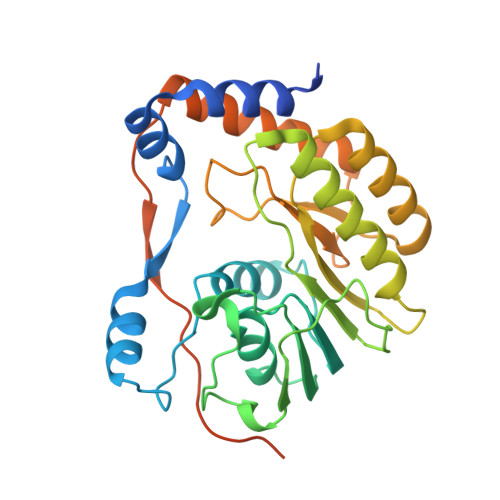Recognition of RNA Cap in the Wesselsbron Virus NS5 Methyltransferase Domain: Implications for RNA-Capping Mechanisms in Flavivirus
Bollati, M., Milani, M., Mastrangelo, E., Ricagno, S., Tedeschi, G., Nonnis, S., Decroly, E., Selisko, B., de Lamballerie, X., Coutard, B., Canard, B., Bolognesi, M.(2009) J Mol Biol 385: 140-152
- PubMed: 18976670
- DOI: https://doi.org/10.1016/j.jmb.2008.10.028
- Primary Citation of Related Structures:
3ELD, 3ELU, 3ELW, 3ELY, 3EMB, 3EMD - PubMed Abstract:
The mRNA-capping process starts with the conversion of a 5'-triphosphate end into a 5'-diphosphate by an RNA triphosphatase, followed by the addition of a guanosine monophosphate unit in a 5'-5' phosphodiester bond by a guanylyltransferase. Methyltransferases are involved in the third step of the process, transferring a methyl group from S-adenosyl-l-methionine to N7-guanine (cap 0) and to the ribose 2'OH group (cap 1) of the first RNA nucleotide; capping is essential for mRNA stability and proper replication. In the genus Flavivirus, N7-methyltransferase and 2'O-methyltransferase activities have been recently associated with the N-terminal domain of the viral NS5 protein. In order to further characterize the series of enzymatic reactions that support capping, we analyzed the crystal structures of Wesselsbron virus methyltransferase in complex with the S-adenosyl-l-methionine cofactor, S-adenosyl-l-homocysteine (the product of the methylation reaction), Sinefungin (a molecular analogue of the enzyme cofactor), and three different cap analogues (GpppG, (N7Me)GpppG, and (N7Me)GpppA). The structural results, together with those on other flaviviral methyltransferases, show that the capped RNA analogues all bind to an RNA high-affinity binding site. However, lack of specific interactions between the enzyme and the first nucleotide of the RNA chain suggests the requirement of a minimal number of nucleotides following the cap to strengthen protein/RNA interaction. Our data also show that, following incubation with guanosine triphosphate, Wesselsbron virus methyltransferase displays a guanosine monophosphate molecule covalently bound to residue Lys28, hinting at possible implications for the transfer of a guanine group to ppRNA. The structures of the Wesselsbron virus methyltransferase complexes obtained are discussed in the context of a model for N7-methyltransferase and 2'O-methyltransferase activities.
Organizational Affiliation:
Department of Biomolecular Sciences and Biotechnology, CNR-INFM and CIMAINA, University of Milano, Milan, Italy.

















